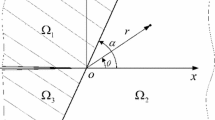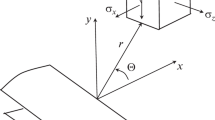Abstract
Based on the sixth order Reissner plate theory, the generalized displacement functions for a cracked plate are derived by eigenfunction expansion method. The fractal two-level finite element method is employed to obtain the stress (moment and shear) intensity factors for the center cracked plate subjected to out-of-plane bending and twisting loads. The numerical results from the present method are checked with those available in literature. Highly accurate stress intensity factors are predicted for a wide range of thickness to crack length ratio and a full range of PoissonÆs ratio provided that the radius of fractal mesh to thickness ratio is not less than \(\frac{1}{{10}}\).
Similar content being viewed by others
References
Alwar, R.S. and Ramachandran Nambissan, K.N. (1983). Three-dimensional finite element analysis of cracked thick plates in bending. International Journal for Numerical Methods in Engineering 19, 293-303.
Barsoum, R.S. (1976). A degenrate solid element for linear fracture analysis of plate bending and general shells. International Journal for Numerical Methods in Engineering 10, 551-564.
Boduroglu, H. and Erdogan, F. (1983). Internal and edge cracks in a plate of finite width under bending. Journal of Applied Mechanics 50 621-629.
Hartranft, R.J. and Sih, G.C. (1968). Effect of plate thickness on the bending stress distribution around through cracks. Journal of Mathematics and Physics 47, 276-291.
Hartranft, R.J. and Sih, G.C. (1969). The use of eigenfunction expansions in general solution of three-dimensional crack problem. Journal of Mathematics and Mechanics 19, 123-138.
Huang, M. and Long, Y. (1988). Calculation of stress intensity factors of cracked Reissner plates by the sub-region mixed finite element method. Computers and Structures 30, 837-840.
Hui, C.Y. and Zehnder, A.T. (1993). A theory for the fracture of thin plates subjected to bending and twisting moments. International Journal of Fracture 61, 211-229.
Irwin, G.R. (1957). Analysis of stresses and strains near the end of a crack transversing a plate. Journal of Applied Mechanics 24, 361-364.
Joseph, P.F. and Erdogan, F. (1991). Bending of a thin Reissner plate with a through crack. Journal of Applied Mechanics 58, 842-846.
Joseph, P.F. and Erdogan, F. (1989). Surface crack problems in plates. International Journal of Fracture 41, 105-131.
Knowles, J.K. and Wang, N.M. (1960). On the bending of n elastic plate containing a crack. Journal of Mathematics and Physics 39, 223-236.
Leung, A.Y.T. and Su, R.K.L. (1996a). Fractal two-level finite element analysis of cracked Reissner's plate. Thin Walled Structures 24, 315-334.
Leung, A.Y.T and Su, R.K.L. (1996b). Fractal two-level finite element method for cracked classical plates using DKT elements. Engineering Fracture Mechanics 54, 703-711.
Leung, A.Y.T. and Su, R.K.L. (1994). Mode I crack problems by fractal two-level finite element methods. Engineering Fracture Mechanics 48, 847-856.
Leung, A.Y.T. and Su, R.K.L. (1995a). Mixed mode two-dimensional crack problems by fractal two-level finite element method. Engineering Fracture Mechanics 51, 889-895.
Leung, A.Y.T. and Su, R.K.L. (1995b). Body-force linear elastic stress intensity factor calculation using fractal two-level finite element method. Engineering Fracture Mechanics 51, 879-888.
Murthy, M.V.V. Raju, K.N. and Viswanath, S. (1981). On the bending stress distribution at the tip of a stationary crack from Reissner's theory. International Journal of Fracture 17, 537-552.
Murthy, M.V.V. Viswanath, S. Krishna Murty, A.V. and Rao, K.P. (1988). A two-dimensional model for crack closure effect in plates under bending. Engineering Fracture Mechanics 29, 435-452.
Rhee, H.C. and Atluri, S.N. (1982). Hybrid stress finite element analysis of bending of a plate with a through flaw. International Journal for Numerical Methods in Engineering 18, 259-271.
Sih, G.C. Paris, P.C. and Erdogan, F. (1962). Crack-tip, stress intensity factors for the plane extension and plate bending problem. Journal of Applied Mechanics 29, 306-312.
Sosa, H.A. and Eischen, J.W. (1986). Computation of stress intensity factors for plate bending via a pathindependent integral. Engineering Fracture Mechanics 25, 451-462.
Sosa, H.A. (1986). On The Analysis of Bars, Beams and Plates with Defects, Ph.D. Thesis, Stanford University.
Viswanath, S. and Murthy, M.V.V. (1989). A special crack tip element for bending of plates with through cracks from a sixt-order plate theory. Engineering Fracture Mechanics 32, 91-109.
Viswanath, S. Lakshminarayana, H.V. and Ravindranath, D.D. (1989). A modified crack closure integral method for calculating stress intensity factors for cracked plates subject to bending loads. International Journal of Fracture 41, R45-50.
Wahba, N.N. (1985). On the use of singular displacement finite elements for cracked plate in bending. International Journal of Fracture 27, 3-30.
Wang, N.M. (1968). Effects of plate thickness on the bending of an elastic plate containing a crack. Journal of Mathematics and Physics 47, 371-390.
Wang, N.M. (1970). Twisting of an elastic plate containing a crack. International Journal of Fracture Mechanics 6, 367-378.
Yagawa, G. and Nishioka, T. (1979). Finite element analysis of stress intensity factors for plane extnsion and plate bending problems. International Journal for Numerical Methods in Engineering 14, 727-740.
Young, M.J. and Sun, C.T. (1993a). Cracked plates subjected to out-of-plane tearing loads. International Journal of Fracture 60, 1-18.
Young, M.J. and Sun, C.T. (1993b). On the strain energy release rate for a cracked plate subjected to out-to-plane bending moment. International Journal of Fracture 60, 227-247.
Zienkiewicz, O.C. and Taylor, R.L. (1991). The Finite Element Method, fourth edition, 2, McGraw-Hill, New York.
Author information
Authors and Affiliations
Rights and permissions
About this article
Cite this article
Su, R., Leung, A. Mixed mode cracks in Reissner plates. International Journal of Fracture 107, 235–257 (2001). https://doi.org/10.1023/A:1007652028645
Issue Date:
DOI: https://doi.org/10.1023/A:1007652028645




